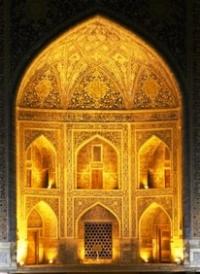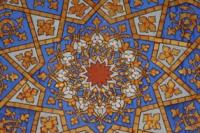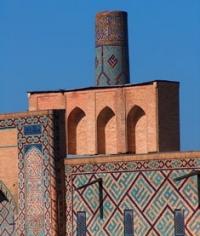Вы здесь
Architectural complex Registan.




Places of interest of Registan.
«Memory is the treasure house of the mind wherein the monuments thereof are kept and preserved»
Thomas Fuller.
Luxury travellers in Samarkand.
In the XIVth century, after the Mongolian devastation, when Afrasiab became deserted, the urban life switched southward. Registan, translated as “sandy place”, became a central square of Samarkand.
Earlier there was a channel, having formed deposits of sands and silt. The old cathedral mosque was built on the square, beside which was mazar at the tomb of imam Muhammad ibn Dja’far.
Six main streets radiated from Registan. At the time of Amir Temur, Registan became the official trading, industrial and public centre of Samarkand, which was connected with the citadel by the street of “silver rows”.
On behalf of Amir Temur’s wife, Tuman-aka, a huge dome arcade – tim Tilpak-furushan was constructed on the crossroad. Four years after the death of Amir Temur, in 1409, his youngest son Shahruh became a king and transferred the capital to Herat.
It is worth coming а11 this way for the Registan, the most spectacular architectural ensemble in Central Asia and the centre of Samarkand since the Mongol invasion. When you see the three great madrasas the first time, rising petrol blue through the petrol fumes, it's hard not to feel you have arrived somewhere significant.
Registan (pronounced with а hard 'g') means 'place of sand'-it was strewn on the ground to soak up the blood from the public executions that were held here until early this century. This is where Tamerlane stuck his victims' heads оп spikes, and where people gathered to hear royal proclamations, heralded by blasts оп enormous copper pipes called dzharchis.
But first and foremost this was а market; а riot of stalls and stallholders' shacks until Tamerlane had them flattened his grand bazaar in 1404. During the next forty years, Samarkand was the capital of Mirzo Ulugbeg’s domain.
At the time of Ulugbeg, Registan became a major ceremonial and official square. Here, they arranged displays of troops, announcement of decrees, etc. Ulugbeg managed to obtain a special sanction of the clergy to dismantle and replace tim of Tuman-aka from Registan.
The square had been added by monumental buildings on perimeter, which determined Registan as a spiritual center of Samarkand and its architectural symbol. The first was a majestic madrasah, comparable with the largest imperial buildings of Temur.
Opposite the madrasah, Ulugbeg constructed huge Sufi khanaka. In the 1430s, Temurid minister Alik Kukeltash built a new djuma-mosque at the southern edge of the square, on a place of the old cathedral mosque.
Beside it, was constructed the small mosque of Mukatta or Hazret Umar, which ruins had still kept in the XIX c. At the northern side of the square was built Mirzoi caravanserai, which income was in favour of the madrasah.
At the beginning of the XVI century, to the east from Registan, Shaybani-khan, the founder of the Shaybanid dynasty, started the construction of the madrasah. Opposite Shaybani-khan’s madrasah, was constructed Haniyyah madrasah.
In the second decade of the XVI c., Registan ensemble was added by Abu-Sa’id-khan madrasah, known as Kok-Gumbaz, located in the south. From the middle of the 1530s, the construction on Registan was stopped, and old buildings gradually fell into decay.
The construction was renewed by the powerful governor of Samarkand, Yalangtush-biy in the 1620s - 1660s, in the period of the Astarkhanids reigning in Bukhara khanate. The attempts to restore Ulugbeg’s khanaka failed, due to its ponderous dome and at the first third of the XVII century, Sher-Dor madrasah was built instead of it.
Later, in the mid - XVIII century, Tillya-Kari madrasah was built on the place of Mirzoi caravanserai, and the lower part of ancient walls became foundations for new ones.
Authority:
Alexey Arapov. Samarkand. Masterpieces of Central Asia. Tashkent, San’at. 2004.
Photos by
Alexander Petrov.







